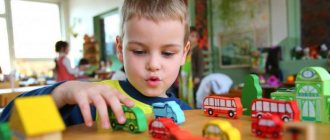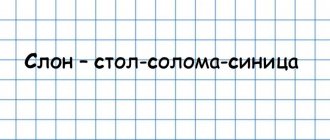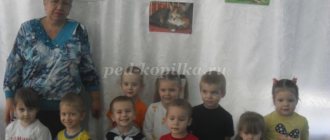Exercises 1-2 years
1. Games with colors. "Colorful Ice Cream" You will need multi-colored cups and balls of corresponding colors. Place your child's favorite toys in a circle. The child is invited to feed the guests ice cream. For example, the bear has a red shirt and wants red ice cream. A red ball is placed in a red cup and offered to the bear. 2. Playing with the material. Chiffon is a wonderful material for play. With its help, it is easy to introduce a child to color and texture, and the concept of “light” is also easy to grasp. In addition, chiffon is transparent. “Colored Mom” or “Colored View of the World.” These games are based on a child’s favorite game – hide and seek. Mom throws chiffon scarves of different colors over herself. The child finds it easily. In addition, you will soon understand what color mom likes best. Now play the same game with your child. Throw colored scarves over it, through them the smiling mother is clearly visible and the world takes on a completely different shade. 3. Games with dough, sand, bulk materials. The kitchen is a particularly attractive place for children. And mom spends a lot of time in the kitchen. Why not turn this place into an exciting land for your little explorer. "Grains for chicken." You will need a green piece of paper and a toy chicken. Explain to your child that the paper is a clearing and the chicken has come to peck the grains. Give your child a piece of hard dough, from which he will pinch off the grains and put them in the clearing to feed the chicken. The hen always thanks the baby. "Plasticine fishing" Together with your child, pinch pieces of multi-colored plasticine. These will be fish. Attach the rolled plasticine sausage to a stick - this is a fishing rod. Now try to catch a fish. If the pieces of plasticine are small and not glued to the surface, they will easily stick to the fishing rod. Place the catch in the lid. Then you can release the fish “back to the sea” and, if desired, start the game from the beginning. 4. Games with paints. "Painting with sponges." Good for printing and sponges. They allow you to print different images. You can cut out interesting figures yourself or look for them in the store. A sponge can be used to smear both paint and thread. If the child does it himself first, then he must be taught how to apply it. To do this, take the child's hand in yours. With the help of printed images, you can get your first subject pictures: ducklings swimming in a pond, cows walking in a meadow, a flower bed, etc. “Painting with rollers” Spread a large sheet of paper on the floor. Choose a small, lightweight foam roller for your baby, which is used for apartment renovations. Dip it and paint. Show me how to roll a roller on a sheet. Perhaps such “painting” works will appeal to the taste of the young artist. You can pre-glue the silhouettes of some figures onto the sheet. And after the paint dries, peel off the templates. Maybe the kid will try to guess what he drew. “Drawing with Mommy's Lipstick” Little children love watching their mothers use cosmetics for their intended purpose. But if suddenly the baby gets into the hands of his mother’s lipstick, then the result of its use can be unpredictable. Since the forbidden fruit is especially desirable for a child, try to discourage it by painting with cosmetics in an organized manner. Give your child a large piece of paper. Choose from your collection of old lipsticks or those whose colors have gone out of fashion, or buy inexpensive lipsticks in the colors you want in the store. Please note that long lipsticks quickly break under pressure from the baby, so it is better to shorten them immediately. Explain to the baby that these are for him, and the others are his mother’s and should not be touched. Immediately after playing, remove such materials out of the child’s reach. You can draw with old eye shadow, rubbing it with your fingers, cotton swabs or unnecessary brushes from a cosmetic set. You can also use nail polish for painting crafts, but with extreme caution, since if the baby gets dirty, you will have to wash it with a solvent. It is better not to use adult cosmetics to paint a child’s face, as this can cause an allergic reaction on the skin. For body art, use special children's makeup paints. 5. Games with construction. “Sponge construction set” Buy several sets of sponges for washing dishes at a hardware store. This is a great material for building and stimulating a child's exploration skills. Thanks to the rough surface, the sponge towers do not fall apart. This material, used together with wooden cubes, allows the child to feel the difference between light and heavy objects, soft and hard, since sponges, unlike cubes, can be easily squeezed in the hand. And if you add water during the research, the child can verify in practice that the foam easily absorbs water. 6. Finger training Children really enjoy playing with their fingers, especially if they are accompanied by funny poems. Try to involve as many fingers as possible in the game. Movements should be moderately energetic. Here are some examples of such games. “Centipedes” Two centipedes ran along the path, (The index and middle fingers of the right hand “run” down the left hand.) They ran, they ran (Now the left hand “runs” down the right hand.) And they met each other, (Interlace their fingers “in castle.") They hugged each other so much (Squeeze intertwined fingers tightly.) That we barely separated them. (With an effort, open your hands.)
“Birds” Two birds were flying, not very tall. (Waving the hands.) As they flew, All the people looked, (Apply the index fingers and thumbs, forming rings to the eyes.) They flew, flew, (Wave the hands.) They sat down and sat, (Put the hands on the head.) Soared , flew away. (Swing your hands.)
psychological games for children 3-4 years old
Games aimed at developing the child’s psychological stability and emotional contact with others
Dad (mom) does this...
Purpose of the game: development of mutual understanding, observation, imitation ability, skills in handling tools.
Necessary materials and visual aids : rag, screwdriver, knife, hammer, etc.
Progress of the game: It is best to play on Sundays, when the whole family is gathered, there are common things that need to be done to make the house cozy and clean.
If the mother is cleaning, she can ask the child to put away the toys, but, as a rule, children are reluctant to fulfill this request, so the mother should use a trick and change roles with the baby, now the child is the mother, and the mother is his daughter. The mother slowly collects the toys, the baby wipes the dust, tries to wash the floors, and vacuum. Mom introduces an additional element to the game: she asks to show where to put the toys away, and offers the game “Who can collect the toys faster.” The child, as a rule, picks up the game and puts away the toys along with his mother. At the end of the game, you need to praise the baby for his speed and agility, say that he is very big and cannot be kept up with him.
A child can provide all possible assistance in housekeeping, he should have a defined range of responsibilities, but taking into account the fact that when they are completed, you can praise the baby, emphasizing the fact that he is growing and learning everything very quickly and doing everything almost like dad or mom.
It may happen that when doing some homework, the child begins to get nervous and angry. In this case, you should pay special attention to your own emotions when doing homework, because the child’s behavior in this case is a direct reflection of your actions. Analyze your behavior and you will understand the reasons for your baby’s “bad” behavior.
Screen
Purpose of the game : development of control over feelings and actions, restoration of emotional contact, development of will, psychological defense.
Recommendations : the task is performed slowly, without forcing events. It takes time to master the exercise.
How to play : Before going to bed during the day or at night, sit next to your child (near the bed or on the bed), Ask him to close his eyes, look at his facial expression, run your hand over his body from his forehead to his toes. Observe how your baby's facial expression changes. As a rule, the tense expression is replaced by a calmer and relaxed one (1). Ask your child to imagine a TV screen in front of him, ask what color it is (2), and then ask him to mentally paint it green (blue or another color that the child likes) (3). Again, observe the baby's facial expression. It is necessary to ensure that he performs all actions calmly, without tension. If you notice that it is difficult for him to do this, then again and again run over his body from the top of his head to the tips of his toes. You can stroke only the face with gentle movements, as if washing the baby and relaxing his tense muscles (4). After all the manipulations, ask your child what color the TV screen is currently. For many children, the object itself disappears from their thoughts, for many it loses its color, and only for some, both the screen and its color remain. Such children are most capable of internal control.
If something has changed for the baby, ask him to imagine the screen again, paint it blue (the color of the sky) and imagine how clouds are floating across the sky, how slowly they float, ask the child to swim with the clouds (5). If the child performs the exercise correctly, his body becomes relaxed and his facial expression becomes calm. After doing the exercise and even during it, he easily falls asleep.
The exercise is divided into several stages (in this case, 5), each of them requires time to master; for each child this time period is individual. The criteria for correctly performing exercises during the game are a calm facial expression and even breathing. If these signs appear, then you can move forward.
This exercise can be used when the child is tired, overexcited, cannot fall asleep, or is capricious.
Note to parents. Listen carefully to your child’s questions, note what he prefers to do, and observe his natural interests.
If I were an adult
Purpose of the game: development of psychological defense, the ability to formulate one’s thoughts, restoration of emotional comfort when communicating.
Necessary materials and visual aids : tape recorder (dictaphone), sketchbook, colored pencils.
Recommendations : Listen carefully to the child’s story or, best of all, write it down so you can analyze it yourself.
Progress of the game : invite the child to speak on the topic “if I were an adult...”. This is necessary to see the hidden negative consequences of upbringing, therefore, to find methods to eliminate them. In his story, the child will directly or indirectly make it clear what he is not happy with in his life, what he would like to change.
Invite your child to draw what he would do if he were an adult.
By comparing the story with the picture, you can find common ground with your child to restore the shaky balance in your relationship.
Note to parents . A child never considers himself small, he is always an adult, from the second day of life (Selma Freiberg, 1956).
Tips and tricks for parents
➣ Children experience disappointment and annoyance if they see that their parents are not interested in their thoughts and feelings, so they conclude that their thoughts are stupid, and no one loves them.
➣ Keep a diary where you will note your child’s achievements, which is an incentive for self-improvement.
➣ Don’t stop your child from being a child, don’t stop him from developing naturally, don’t stop him from being independent, brave, truthful, and kind.
➣ During this period (4-6 years), children are characterized by a predominance of feelings over reason.
➣ By protecting children from difficulties, you become the progenitors of uncertainty, passivity, inability and unwillingness to cope with the problems that arise.
Source
Junior group. Early childhood, nursery. Children 1-4 years old
Summary of a complex lesson with elements of psychological training for children 1.5–2 years old “Feelings are more important than words” MDOU “Kindergarten No. 157”
Summary of a complex lesson with elements of psychological training for children 1.5–2 years old. “Feelings are more important than words”
Prepared by: teacher-
psychologist Mikhailova A.L. Yaroslavl 2021 “Feelings are more important than words”
Equipment. Boxes Masha and the Bear, hoop, ribbons,…
Emotional perception of beauty by young children in music classes Emotional perception of beauty by young children in music classes Early childhood is a period of intense physical and mental development . At this stage, fundamental human abilities are laid. The period of early childhood is unique and...







